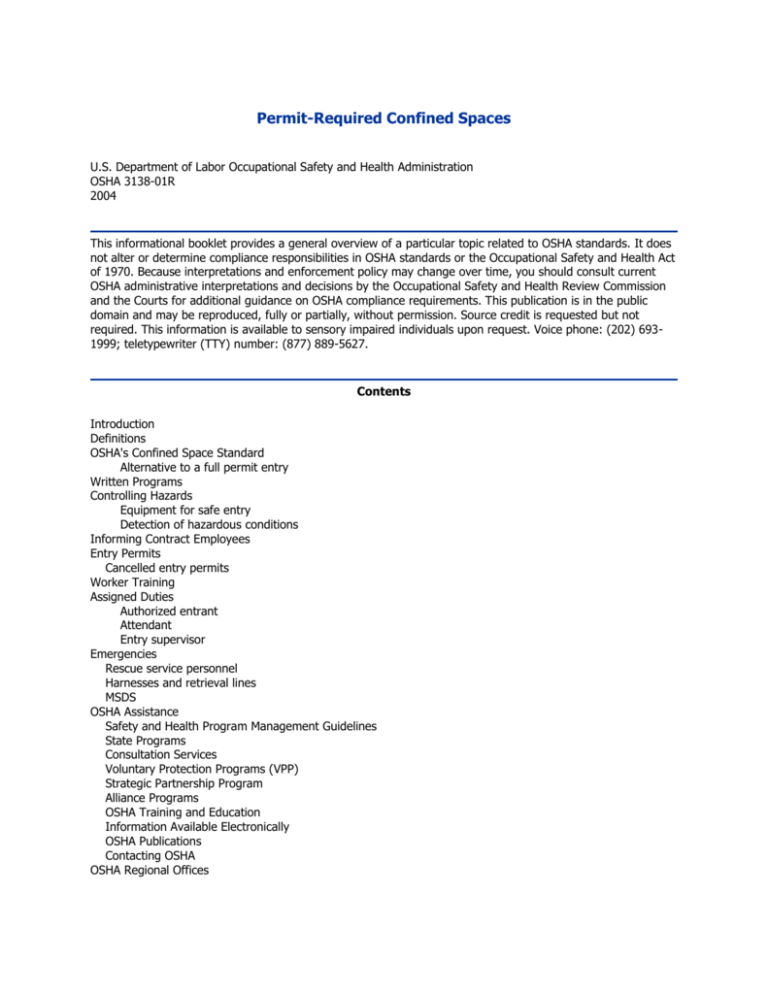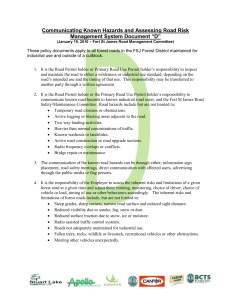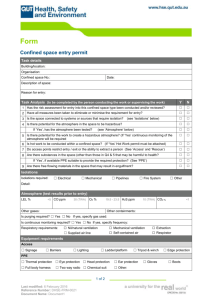OSHA Confined Space Program
advertisement

Permit-Required Confined Spaces U.S. Department of Labor Occupational Safety and Health Administration OSHA 3138-01R 2004 This informational booklet provides a general overview of a particular topic related to OSHA standards. It does not alter or determine compliance responsibilities in OSHA standards or the Occupational Safety and Health Act of 1970. Because interpretations and enforcement policy may change over time, you should consult current OSHA administrative interpretations and decisions by the Occupational Safety and Health Review Commission and the Courts for additional guidance on OSHA compliance requirements. This publication is in the public domain and may be reproduced, fully or partially, without permission. Source credit is requested but not required. This information is available to sensory impaired individuals upon request. Voice phone: (202) 6931999; teletypewriter (TTY) number: (877) 889-5627. Contents Introduction Definitions OSHA's Confined Space Standard Alternative to a full permit entry Written Programs Controlling Hazards Equipment for safe entry Detection of hazardous conditions Informing Contract Employees Entry Permits Cancelled entry permits Worker Training Assigned Duties Authorized entrant Attendant Entry supervisor Emergencies Rescue service personnel Harnesses and retrieval lines MSDS OSHA Assistance Safety and Health Program Management Guidelines State Programs Consultation Services Voluntary Protection Programs (VPP) Strategic Partnership Program Alliance Programs OSHA Training and Education Information Available Electronically OSHA Publications Contacting OSHA OSHA Regional Offices Introduction Many workplaces contain spaces that are considered to be "confined" because their configurations hinder the activities of employees who must enter into, work in or exit from them. In many instances, employees who work in confined spaces also face increased risk of exposure to serious physical injury from hazards such as entrapment, engulfment and hazardous atmospheric conditions. Confinement itself may pose entrapment hazards and work in confined spaces may keep employees closer to hazards such as machinery components than they would be otherwise. For example, confinement, limited access and restricted airflow can result in hazardous conditions that would not normally arise in an open workplace. The terms "permit-required confined space" and "permit space" refer to spaces that meet OSHA's definition of a "confined space" and contain health or safety hazards. For this reason, OSHA requires workers to have a permit to enter these spaces. Throughout this publication, the term "permit space" will be used to describe a "permit-required confined space." Definitions By definition, a confined space: Is large enough for an employee to enter fully and perform assigned work; Is not designed for continuous occupancy by the employee; and Has a limited or restricted means of entry or exit. These spaces may include underground vaults, tanks, storage bins, pits and diked areas, vessels, silos and other similar areas. By definition, a permit-required confined space has one or more of these characteristics: Contains or has the potential to contain a hazardous atmosphere; Contains a material with the potential to engulf someone who enters the space; Has an internal configuration that might cause an entrant to be trapped or asphyxiated by inwardly converging walls or by a floor that slopes downward and tapers to a smaller cross section; and/or Contains any other recognized serious safety or health hazards. OSHA's Confined Space Standard OSHA's standard for confined spaces (29 CFR 1910.146) contains the requirements for practices and procedures to protect employees in general industry from the hazards of entering permit spaces. Employers in general industry must evaluate their workplaces to determine if spaces are permit spaces. (See flow chart, page 5.) If a workplace contains permit spaces, the employer must inform exposed employees of their existence, location and the hazards they pose. This can be done by posting danger signs such as "DANGER -- PERMIT-REQUIRED CONFINED SPACE -- AUTHORIZED ENTRANTS ONLY" or using an equally effective means. If employees are not to enter and work in permit spaces, employers must take effective measures to prevent them from entering these spaces. If employees are expected to enter permit spaces, the employer must develop a written permit space program and make it available to employees or their representatives. Alternative to a full permit entry Under certain conditions described in the standard, the employer may use alternate procedures for worker entry into a permit space. For example, if an employer can demonstrate with monitoring and inspection data that the only hazard is an actual or potential hazardous atmosphere that can be made safe for entry using continuous forced air ventilation, the employer may be exempted from some requirements, such as permits and attendants. However, even in these circumstances, the employer must test the internal atmosphere of the space for oxygen content, flammable gases and vapors, and the potential for toxic air contaminants before any employee enters it. The employer must also provide continuous ventilation and verify that the required measurements are performed before entry. Permit-Required Confined Space Decision Flow Chart Written Programs Any employer who allows employee entry into a permit space must develop and implement a written program for the space. Among other things, the OSHA standard requires the employer's written program to: Implement necessary measures to prevent unauthorized entry; Identify and evaluate permit space hazards before allowing employee entry; Test atmospheric conditions in the permit space before entry operations and monitor the space during entry; Perform appropriate testing for the following atmospheric hazards in this sequence: oxygen, combustible gases or vapors, and toxic gases or vapors; Establish and implement the means, procedures and practices to eliminate or control hazards necessary for safe permit space entry operations; Identify employee job duties; Provide and maintain, at no cost to the employee, personal protective equipment and any other equipment necessary for safe entry and require employees to use it; Ensure that at least one attendant is stationed outside the permit space for the duration of entry operations; Coordinate entry operations when employees of more than one employer are working in the permit space; Implement appropriate procedures for summoning rescue and emergency services, and preventing unauthorized personnel from attempting rescue; Establish, in writing, and implement a system for the preparation, issue, use and cancellation of entry permits; Review established entry operations annually and revise the permit space entry program as necessary; and Implement the procedures that any attendant who is required to monitor multiple spaces will follow during an emergency in one or more of those spaces. Controlling Hazards The employer's written program should establish the means, procedures and practices to eliminate or control hazards necessary for safe permit space entry operations. These may include: Specifying acceptable entry conditions; Isolating the permit space; Providing barriers; Verifying acceptable entry conditions; and Purging, making inert, flushing or ventilating the permit space. Equipment for safe entry In addition to personal protective equipment, other equipment that employees may require for safe entry into a permit space includes: Testing, monitoring, ventilating, communications and lighting equipment; Barriers and shields; Ladders; and Retrieval devices. Detection of hazardous conditions If hazardous conditions are detected during entry, employees must immediately leave the space. The employer must evaluate the space to determine the cause of the hazardous atmosphere and modify the program as necessary. When entry to permit spaces is prohibited, the employer must take effective measures to prevent unauthorized entry. Non-permit confined spaces must be evaluated when changes occur in their use or configuration and, where appropriate, must be reclassified as permit spaces. A space with no potential to have atmospheric hazards may be classified as a non-permit confined space only when all hazards are eliminated in accordance with the standard. If entry is required to eliminate hazards and obtain data, the employer must follow specific procedures in the standard. Informing Contract Employees Employers must inform any contractors whom they hire to enter permit spaces about: The permit spaces and permit space entry requirements; Any identified hazards; The employer's experience with the space, such as knowledge of hazardous conditions; and Precautions or procedures to be followed when in or near permit spaces. When employees of more than one employer are conducting entry operations, the affected employers must coordinate entry operations to ensure that affected employees are appropriately protected from permit space hazards. The employer also must give contractors any other pertinent information regarding hazards and operations in permit spaces and be debriefed at the conclusion of entry operations. Entry Permits A permit, signed by the entry supervisor, must be posted at all entrances or otherwise made available to entrants before they enter a permit space. The permit must verify that pre-entry preparations outlined in the standard have been completed. The duration of entry permits must not exceed the time required to complete an assignment. Entry permits must include: Name of permit space to be entered, authorized entrant(s), eligible attendants and individuals authorized to be entry supervisors; Test results; Tester's initials or signature; Name and signature of supervisor who authorizes entry; Purpose of entry and known space hazards; Measures to be taken to isolate permit spaces and to eliminate or control space hazards; Name and telephone numbers of rescue and emergency services and means to be used to contact them; Date and authorized duration of entry; Acceptable entry conditions; Communication procedures and equipment to maintain contact during entry; Additional permits, such as for hot work, that have been issued authorizing work in the permit space; Special equipment and procedures, including personal protective equipment and alarm systems; and Any other information needed to ensure employee safety. Cancelled entry permits The entry supervisor must cancel entry permits when an assignment is completed or when new conditions exist. New conditions must be noted on the canceled permit and used in revising the permit space program. The standard requires that the employer keep all canceled entry permits for at least one year. Worker Training Before the initial work assignment begins, the employer must provide proper training for all workers who are required to work in permit spaces. After the training, employers must ensure that the employees have acquired the understanding, knowledge and skills necessary to safely perform their duties. Additional training is required when: The job duties change; A change occurs in the permit space program or the permit space operation presents any new hazard; and An employee's job performance shows deficiencies. In addition to this training, rescue team members also require training in CPR and first aid. Employers must certify that this training has been provided. After completion of training, the employer must keep a record of employee training and make it available for inspection by employees and their authorized representatives. The record must include the employee's name, the trainer's signature or initials and dates of the training. Assigned Duties Authorized entrant Authorized entrants are required to: Know space hazards, including information on the means of exposure such as inhalation or dermal absorption, signs of symptoms and consequences of the exposure; Use appropriate personal protective equipment properly; Maintain communication with attendants as necessary to enable them to monitor the entrant's status and alert the entrant to evacuate when necessary; Exit from the permit space as soon as possible when: Ordered by the authorized person; He or she recognizes the warning signs or symptoms of exposure; A prohibited condition exists; or An automatic alarm is activated. Alert the attendant when a prohibited condition exists or when warning signs or symptoms of exposure exist. Attendant The attendant is required to: Remain outside the permit space during entry operations unless relieved by another authorized attendant; Perform non-entry rescues when specified by the employer's rescue procedure; Know existing and potential hazards, including information on the mode of exposure, signs or symptoms, consequences and physiological effects; Maintain communication with and keep an accurate account of those workers entering the permit space; Order evacuation of the permit space when: A prohibited condition exists; A worker shows signs of physiological effects of hazard exposure; An emergency outside the confined space exists; and The attendant cannot effectively and safely perform required duties. Summon rescue and other services during an emergency; Ensure that unauthorized people stay away from permit spaces or exit immediately if they have entered the permit space; Inform authorized entrants and the entry supervisor if any unauthorized person enters the permit space; and Perform no other duties that interfere with the attendant's primary duties. Entry supervisor Entry supervisors are required to: Know space hazards including information on the mode of exposure, signs or symptoms and consequences; Verify emergency plans and specified entry conditions such as permits, tests, procedures and equipment before allowing entry; Terminate entry and cancel permits when entry operations are completed or if a new condition exists; Verify that rescue services are available and that the means for summoning them are operable; Take appropriate measures to remove unauthorized entrants; and Ensure that entry operations remain consistent with the entry permit and that acceptable entry conditions are maintained. Emergencies Rescue service personnel The standard requires employers to ensure that responders are capable of responding to an emergency in a timely manner. Employers must provide rescue service personnel with personal protective and rescue equipment, including respirators, and training in how to use it. Rescue service personnel also must receive the authorized entrants training and be trained to perform assigned rescue duties. The standard also requires that all rescuers be trained in first aid and CPR. At a minimum, one rescue team member must be currently certified in first aid and CPR. Employers must ensure that practice rescue exercises are performed yearly and that rescue services are provided access to permit spaces so they can practice rescue operations. Rescuers also must be informed of the hazards of the permit space. Harnesses and retrieval lines Authorized entrants who enter a permit space must wear a chest or full body harness with a retrieval line attached to the center of their backs near shoulder level or above their heads. Wristlets may be used if the employer can demonstrate that the use of a chest or full body harness is not feasible or creates a greater hazard. Also, the employer must ensure that the other end of the retrieval line is attached to a mechanical device or a fixed point outside the permit space. A mechanical device must be available to retrieve someone from vertical type permit spaces more than five feet (1.524 meters) deep. MSDS If an injured entrant is exposed to a substance for which a Material Safety Data Sheet (MSDS) or other similar written information is required to be kept at the worksite, that MSDS or other written information must be made available to the medical facility personnel treating the exposed entrant. OSHA Assistance OSHA can provide extensive help through a variety of programs, including technical assistance about effective safety and health programs, state plans, workplace consultations, voluntary protection programs, strategic partnerships, training and education, and more. An overall commitment to workplace safety and health can add value to your business, to your workplace and to your life. Safety and Health Program Management Guidelines Effective management of worker safety and health protection is a decisive factor in reducing the extent and severity of work-related injuries and illnesses and their related costs. In fact, an effective safety and health program forms the basis of good worker protection and can save time and money (about $4 for every dollar spent) and increase productivity and reduce worker injuries, illnesses and related workers' compensation costs. To assist employers and employees in developing effective safety and health programs, OSHA published recommended Safety and Health Program Management Guidelines (54 Federal Register (16): 3904-3916, January 26, 1989). These voluntary guidelines apply to all places of employment covered by OSHA. The guidelines identify four general elements critical to the development of a successful safety and health management program: Management leadership and employee involvement. Work analysis. Hazard prevention and control. Safety and health training. The guidelines recommend specific actions, under each of these general elements, to achieve an effective safety and health program. The Federal Register notice is available online at www.osha.gov.




